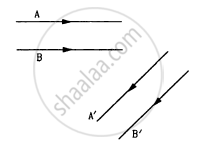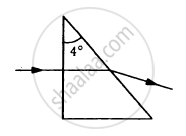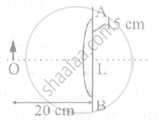Advertisements
Advertisements
Question
The rays of different colours fail to converge at a point after going through a converging lens. This defect is called
Options
spherical aberration
distortion
coma
chromatic aberration.
Solution
chromatic aberration
When light rays of different colours do not converge at the same point after passing through a converging lens, it is called chromatic aberration. This happens because a lens has different refractive indices for different colours, i.e, for different wavelengths of light.
APPEARS IN
RELATED QUESTIONS
Use the mirror equation to show that an object placed between f and 2f of a concave mirror produces a real image beyond 2f.
Use the mirror equation to show that a convex mirror always produces a virtual image independent of the location of the object.
Using mirror formula, explain why does a convex mirror always produce a virtual image.
Define the term 'limit of resolution'?
following Figure shows two rays A and B being reflected by a mirror and going as A' and B'. The mirror
Mark the correct options.
A light ray falling at an angle of 45° with the surface of a clean slab of ice of thickness 1.00 m is refracted into it at an angle of 30°. Calculate the time taken by the light rays to cross the slab. Speed of light in vacuum = 3 × 108 m s−1.
A small object is placed at the centre of the bottom of a cylindrical vessel of radius 3 cm and height 4 cm filled completely with water. Consider the ray leaving the vessel through a corner. Suppose this ray and the ray along the axis of the vessel are used to trace the image. Find the apparent depth of the image and the ratio of real depth to the apparent depth under the assumptions taken. Refractive index of water = 1.33.
A light ray is incident normally on the face AB of a right-angled prism ABC (μ = 1.50) as shown in figure. What is the largest angle ϕ for which the light ray is totally reflected at the surface AC?

Find the angle of deviation suffered by the light ray shown in figure. The refractive index μ = 1.5 for the prism material.

Name the physical principle on which the working of optical fibers is based.
A point object is placed at a distance of 20 cm from a thin plano-convex lens of focal length 15 cm, if the plane surface is silvered. The image will form at:

A parallel beam of light is allowed to fall on a transparent spherical globe of diameter 30cm and refractive index 1.5. The distance from the centre of the globe at which the beam of light can converge is ______ mm.
The focal length f is related to the radius of curvature r of the spherical convex mirror by ______.
Car B overtakes car A at a relative speed of 40 ms-1. How fast will the image of car B appear to move in the mirror of focal length 10 cm fitted in car A, when car B is 1.9 m away from car A?
A point object is placed at a distance of 30 cm from a convex mirror of a focal length of 30 cm. What is the separation between the image and the object?
